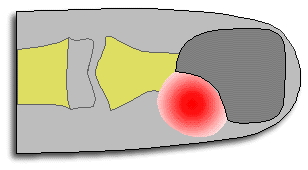
| What is it? |
-
A paronychia is an infection which develops next to the fingernail. It
may arise anywhere around the "U" shaped line where the fingernail doesn't
seem to have a protruding edge - where the edge of the nail is covered
by skin. It may be a mild infection, but often is associated with a small
abscess - a collection of pus beneath the skin. A paronychial infection
may develop suddenly due to a bacterial infection, or may persist for months
or more due to a fungal infection.
|
| What caused it? |
-
Paronychial infections are common because of the way our fingernails are
made. On the surface, it appears that the fingernail (or "nail plate")
is an oval shape:
|

 |
-
However, the whole fingernail is actually rectangular, and three of the
sides are ordinarily covered by skin.
|

 |
-
The skin which overlaps the nail is usually stuck down to the outer surface
of the fingernail. The cuticle is the edge of where the skin is usually
attached. However, there is a little area between the covered portion of
the nail and the skin which covers it - and this area may provide a shelter
space space for bacteria to grow. We all have bacteria on our hands, even
after we wash, and bacteria or fungus may hide and grow in small crevices
next to the fingernail.
-
Paronychia are more common in people whose hands are frequently wet - even
from hand washing - because organisms grow more easily in the crevices
next to the nails which are difficult to dry completely.
|

 |
|
| What can you do to help? |
-
Occasional paronychial infections are probably impossible to prevent. It
is not clear whether or not manicures either prevent or cause nail bed
infections. Most instances develop for no clear reason.
-
The early signs of a nail bed infection is soreness and tenderness in the
area next to the nail. Warm water soaks (water temperature no hotter than
102 degrees F) for ten minutes three times a day - along with gentle massage,
pulling the skin gently sideways away from the nail - may help.
-
If you suspect a nail bed infection, you should have an evaluation by a
physician, especially if you have diabetes or any medical condition which
affects the immune system. Not all painful nail problems are paronychia
- persistent problems should be checked out with a professional.
|
| What can a therapist do to help? |
| A therapist may help identify a painful finger problem as a paronychia,
and put you in contact with a physician. |
| What can a doctor do to help? |
-
Diagnose a paronychial infection and make sure that you don't have a different
medical condition.
-
In some cases, prescribe antibiotics and supervise your progress on them.
-
In some cases - if there is evidence of an abscess - it is best for the
physician to numb the finger with an anesthetic and drain out the infection.
Usually, this simply involves gently opening the space between the nail
and the skin so that any infection will drain out.
-
The fingernail itself may be a source of continued inflammation and infection.
In some situations, it is best to remove the nail plate and let a new fingernail
grow back. This is the most effective way to make sure that all of the
infection is drained out. It sounds worse than it is. Beneath the nail
plate, you have another layer of special skin (the "nail bed") which acts
like a nail until the new nail plate grows back. After a nail plate has
been removed, it is usually necessary to wear a small bandage for less
than a week, and it takes about three months for a complete new nail to
grow back.
|
 |
-
If problems persist and nail infections keep coming back despite these
steps, it may be helpful for a hand surgeon to perform a procedure to make
the nail folds less susceptible to infection. The most common surgery of
this type is called an "eponychial marsupialization" , which involves removing
a small strip of skin next to the nail itself. This procedure is very successful,
but fortunately most people with paronychial infections get better without
needing surgery of this sort.
|
| How successful is treatment? |
-
The great majority of patients with paronychial infections are cured with
proper care.
|
| What happens if you have no treatment? |
-
Many early and mild infections can be treated with several days of warm
soaks.
-
Sometimes, a nail bed abscess will drain on its own.
-
Pain, redness and tenderness may worsen despite home care, and may be due
to a more serious problem.
-
Neglected infections may result in infection tracking up the finger, requiring
much more extensive surgery and posing other health risks - particularly
in people who have diabetes, circulatory or immune system problems.
-
Chronic paronychia often result in nail plate deformities - ridges, rough
surfaces, and discoloration. Chronic nail infections may require treatment
with antifungal medication. nail plate removal and surgery on the skin
of the nail fold.
|
|







